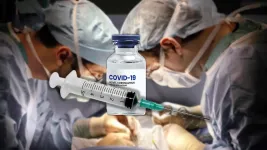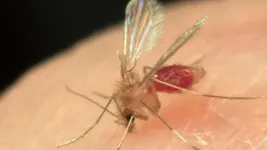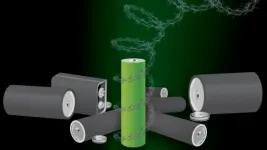INFORMATION:
Penn Medicine is one of the world's leading academic medical centers, dedicated to the related missions of medical education, biomedical research, and excellence in patient care. Penn Medicine consists of the Raymond and Ruth Perelman School of Medicine at the University of Pennsylvania (founded in 1765 as the nation's first medical school) and the University of Pennsylvania Health System, which together form a $8.9 billion enterprise.
The Perelman School of Medicine has been ranked among the top medical schools in the United States for more than 20 years, according to U.S. News & World Report's survey of research-oriented medical schools. The School is consistently among the nation's top recipients of funding from the National Institutes of Health, with $496 million awarded in the 2020 fiscal year.
The University of Pennsylvania Health System's patient care facilities include: The Hospital of the University of Pennsylvania and Penn Presbyterian Medical Center--which are recognized as one of the nation's top "Honor Roll" hospitals by U.S. News & World Report--Chester County Hospital; Lancaster General Health; Penn Medicine Princeton Health; and Pennsylvania Hospital, the nation's first hospital, founded in 1751. Additional facilities and enterprises include Good Shepherd Penn Partners, Penn Medicine at Home, Lancaster Behavioral Health Hospital, and Princeton House Behavioral Health, among others.
Penn Medicine is powered by a talented and dedicated workforce of more than 44,000 people. The organization also has alliances with top community health systems across both Southeastern Pennsylvania and Southern New Jersey, creating more options for patients no matter where they live.
Penn Medicine is committed to improving lives and health through a variety of community-based programs and activities. In fiscal year 2020, Penn Medicine provided more than $563 million to benefit our community.
Penn study reveals how opioid supply shortages shape emergency department prescribing behaviors
Injectable opioid shortage in 2018 led to less opioid use overall, yet no significant change in opioid dosing, Penn Medicine research finds
2021-05-06
(Press-News.org) PHILADELPHIA-- When evaluating the opioid crisis, research reveals that external factors - such as the volume of pre-filled syringes, or a default number of opioid tablets that could easily be ordered at discharge for the patient - can shift prescribing and compel emergency department (ED) physicians to administer or prescribe greater quantities of opioids. A new study published in the Journal of Medical Toxicology reveals that opioid prescribing behavior can also be decreased by external factors, such as a supply shortage.
Led by the Perelman School of Medicine at the University of Pennsylvania, researchers evaluated pharmacy data from the electronic medical records (EMR) collected before, during, and after a period of parenteral opioid shortage across two large urban academic emergency departments - the Hospital of the University of Pennsylvania and University Hospital in Newark, New Jersey. In this case, the shortage was of parenteral morphine and hydromorphone, as a result of supply chain disruptions caused by Hurricane Maria in 2018.
Researchers found that the percentage of patients who received an opioid among all ED visits during the 2018 shortage fell significantly from 11.5% pre-shortage to 8.5% during, and did not return to baseline once the shortage abated. Further, the total number of oral or IV opioid doses administered during the shortage also decreased and remained lower than pre-shortage levels once supply chains were restored. However, the study also found that while fewer opioid doses were administered to fewer patients, there was no change in net Morphine Milligram Equivalent (MME) per patient receiving opioids.
"Although the percentage of patients who received non-opioid analgesics did not rise during the shortage, it was significantly higher in the post-shortage period," said lead investigator Amanda Deutsch, MD, an Emergency Medicine resident at Penn. "This suggests that a subset of patients were transitioned to non-opioids, and this prescribing practice was a sustained change after the resolution of the shortage."
The study also found that because the shortages were specifically of parenteral morphine and hydromorphone, those were replaced by parenteral fentanyl, but the overall total use in MME of opioids administered remained the same. The use of oral morphine also appeared to increase during the shortage period. These findings may suggest that the shortage may have led to a shift from IV opioid use to oral opioid formulations.
However, researchers felt that the shift in prescribing patterns during the shortage can offer an opportunity for more research into how external factors can influence ED prescribing practices. "Changing clinician prescribing behavior is challenging," said author Jeanmarie Perrone, MD, a professor of Emergency Medicine at Penn. "This study shows encouraging data to support that there are environmental modifications that can nudge providers toward more judicious opioid use."
ELSE PRESS RELEASES FROM THIS DATE:
Scientists discover how to trick cancer cells to consume toxic drugs
2021-05-06
BOSTON - New research led by a team at Massachusetts General Hospital (MGH) points to a promising strategy to boost tumors' intake of cancer drugs, thereby increasing the effectiveness of chemotherapy treatments. The group's findings are published in Nature Nanotechnology.
Getting enough anticancer drugs into a tumor is often difficult, and a potential strategy to overcome this challenge involves binding the medications to albumin, the most abundant protein in blood. The strategy relies on tumors' large appetite for protein nutrients that fuel malignant growth. When consuming available albumin, the tumors will inadvertently take in the attached drugs.
A popular albumin-bound drug approved by the U.S. Food and Drug Administration is ...
Scrap for cash before coins
2021-05-06
How did people living in the Bronze Age manage their finances before money became widespread? Researchers from the Universities of Göttingen and Rome have discovered that bronze scrap found in hoards in Europe circulated as a currency. These pieces of scrap - which might include swords, axes, and jewellery broken into pieces - were used as cash in the late Bronze Age (1350-800 BC), and in fact complied with a weight system used across Europe. This research suggests that something very similar to our 'global market' evolved across Western Eurasia from the everyday use of scrap for cash by ordinary people some 1000 years before the beginning of classical civilizations. The results were published in Journal of Archaeological Science.
This study analysed around ...
'Natural disasters' increase triggers for violence against women and girls
2021-05-06
'Natural disasters,' sparked by climate change and other natural hazards, increase the triggers for violence against women and girls by boosting the means, opportunity, and underlying drivers, finds a review of the available evidence, published in the online journal BMJ Global Health.
As these disasters are increasing in frequency, severity, and duration worldwide, this consequence must now be formally recognised in public health, violence prevention, and disaster management strategies, urge the researchers.
Over the past two decades, 7348 ...
Online learning doesn't improve student sleep habits, research suggests
2021-05-06
New research from Simon Fraser University suggests that students learning remotely become night owls but do not sleep more despite the time saved commuting, working or attending social events.
The study, led by psychology professor Ralph Mistlberger, Andrea Smit and Myriam Juda, at SFU's Circadian Rhythms and Sleep Lab, compared self-reported data on sleep habits from 80 students enrolled in a 2020 summer session course at SFU with data collected from 450 students enrolled in the same course during previous summer semesters. The study results were recently published in the journal PLOS ONE.
"There is a widespread belief among ...
Organ transplant recipients remain vulnerable to COVID-19 even after second vaccine dose
2021-05-06
In a study published today in the Journal of the American Medical Association (JAMA), Johns Hopkins Medicine researchers show that although two doses of a vaccine against SARS-CoV-2 -- the virus that causes COVID 19 -- confers some protection for people who have received solid organ transplants, it's still not enough to enable them to dispense with masks, physical distancing and other safety measures.
This is a follow-up study to an earlier one published in March in JAMA, in which the researchers reported that only 17% of the participating transplant recipients produced sufficient antibodies after just one dose of a two-dose COVID-19 vaccine regimen.
"While there was an ...
Cancer patients lonely and depressed during COVID
2021-05-06
Loneliness and social isolation have been significant problems for the general population during the COVID-19 pandemic, but for cancer patients these issues were particularly acute, likely due to isolation and social distancing, according to a new UCSF study.
The study, which is the first to evaluate loneliness, anxiety, depression, fatigue and other symptoms in a single group of patients, is published in Cancer, a peer-reviewed journal of the American Cancer Society.
"We found that oncology patients were experiencing a deep sense of loneliness," ...
Surprising sand fly find yields new species of bacteria
2021-05-06
Researchers at North Carolina State University and the University of North Carolina Greensboro made a surprising finding while examining areas where sand flies rear their young: a new species of bacteria that is highly attractive to pregnant, or gravid, sand flies. The findings could advance the production of ecologically safe baits or traps to reduce sand fly populations.
Sand flies are vectors for important parasitic diseases affecting people in tropical and subtropical regions in Asia, Africa and the Middle East. One of those diseases is Leishmaniasis, which generally causes ...
In graphene process, resistance is useful
2021-05-06
HOUSTON - (May 6, 2021) - A Rice University laboratory has adapted its laser-induced graphene technique to make high-resolution, micron-scale patterns of the conductive material for consumer electronics and other applications.
Laser-induced graphene (LIG), introduced in 2014 by Rice chemist James Tour, involves burning away everything that isn't carbon from polymers or other materials, leaving the carbon atoms to reconfigure themselves into films of characteristic hexagonal graphene.
The process employs a commercial laser that "writes" graphene patterns into surfaces that to date have included wood, paper and even food.
The new iteration writes fine patterns of graphene into photoresist polymers, light-sensitive materials used in photolithography and ...
Skin and immune cells coordinate defenses against assault
2021-05-06
As the human body's largest organ, the skin is responsible for protecting against a wide range of possible infections on all fleshy surfaces, from head to toe. So how exactly does the skin organize its defenses against such an array of threats?
A new Yale study shows that the epidermis, the outermost layer of skin, is comprised of an army of immune cells that station themselves at regular intervals across the skin's vast expanse to resist infection. When necessary, the researchers found, these immune system soldiers are able to reposition themselves to protect vulnerable areas.
The study, published in the journal Nature Cell Biology, was conducted by the lab of Valentina ...
Researchers develop new metal-free, recyclable polypeptide battery that degrades on demand
2021-05-06
The introduction of lithium-ion (Li-ion) batteries has revolutionized technology as a whole, leading to major advances in consumer goods across nearly all sectors. Battery-powered devices have become ubiquitous across the world. While the availability of technology is generally a good thing, the rapid growth has led directly to several key ethical and environmental issues surrounding the use of Li-ion batteries.
Current Li-ion batteries utilize significant amounts of cobalt, which in several well-documented international cases is mined using child labor in dangerous working ...
LAST 30 PRESS RELEASES:
Injectable breast ‘implant’ offers alternative to traditional surgeries
Neuroscientists devise formulas to measure multilingualism
New prostate cancer trial seeks to reduce toxicity without sacrificing efficacy
Geometry shapes life
A CRISPR screen reveals many previously unrecognized genes required for brain development and a new neurodevelopmental disorder
Hot flush treatment has anti-breast cancer activity, study finds
Securing AI systems against growing cybersecurity threats
Longest observation of an active solar region
Why nail-biting, procrastination and other self-sabotaging behaviors are rooted in survival instincts
Regional variations in mechanical properties of porcine leptomeninges
Artificial empathy in therapy and healthcare: advancements in interpersonal interaction technologies
Why some brains switch gears more efficiently than others
UVA’s Jundong Li wins ICDM’S 2025 Tao Li Award for data mining, machine learning
UVA’s low-power, high-performance computer power player Mircea Stan earns National Academy of Inventors fellowship
Not playing by the rules: USU researcher explores filamentous algae dynamics in rivers
Do our body clocks influence our risk of dementia?
Anthropologists offer new evidence of bipedalism in long-debated fossil discovery
Safer receipt paper from wood
Dosage-sensitive genes suggest no whole-genome duplications in ancestral angiosperm
First ancient human herpesvirus genomes document their deep history with humans
Why Some Bacteria Survive Antibiotics and How to Stop Them - New study reveals that bacteria can survive antibiotic treatment through two fundamentally different “shutdown modes”
UCLA study links scar healing to dangerous placenta condition
CHANGE-seq-BE finds off-target changes in the genome from base editors
The Journal of Nuclear Medicine Ahead-of-Print Tip Sheet: January 2, 2026
Delayed or absent first dose of measles, mumps, and rubella vaccination
Trends in US preterm birth rates by household income and race and ethnicity
Study identifies potential biomarker linked to progression and brain inflammation in multiple sclerosis
Many mothers in Norway do not show up for postnatal check-ups
Researchers want to find out why quick clay is so unstable
Superradiant spins show teamwork at the quantum scale
[Press-News.org] Penn study reveals how opioid supply shortages shape emergency department prescribing behaviorsInjectable opioid shortage in 2018 led to less opioid use overall, yet no significant change in opioid dosing, Penn Medicine research finds




